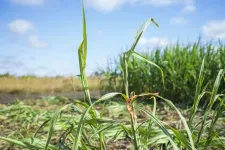(Press-News.org) The silicon microchips of future quantum computers will be packed with millions, if not billions of qubits – the basic units of quantum information – to solve the greatest problems facing humanity. And with millions of qubits needing millions of wires in the microchip circuitry, it was always going to get cramped in there.
But now engineers at UNSW Sydney have made an important step towards solving a long-standing problem about giving their qubits more breathing space -- and it all revolves around jellybeans.
Not the kind we rely on for a sugar hit to get us past the 3pm slump. But jellybean quantum dots –elongated areas between qubit pairs that create more space for wiring without interrupting the way the paired qubits interact with each other.
As lead author Associate Professor Arne Laucht explains, the jellybean quantum dot is not a new concept in quantum computing, and has been discussed as a solution to some of the many pathways towards building the world’s first working quantum computer.
“It has been shown in different material systems such as gallium arsenide. But it has not been shown in silicon before,” he says.
Silicon is arguably one of the most important materials in quantum computing, A/Prof. Laucht says, as the infrastructure to produce future quantum computing chips is already available, given we use silicon chips in classical computers. Another benefit is that you can fit so many qubits (in the form of electrons) on the one chip.
“But because the qubits need to be so close together to share information with one another, placing wires between each pair was always going to be a challenge.”
In a study published today in Advanced Materials, the UNSW team of engineers describe how they showed in the lab that jellybean quantum dots were possible in silicon. This now opens the way for qubits to be spaced apart to ensure that the wires necessary to connect and control the qubits can be fit in between.
How it works
In a normal quantum dot using spin qubits, single electrons are pulled from a pool of electrons in silicon to sit under a ‘quantum gate’ – where the spin of each electron represents the computational state. For example, spin up may represent a 0 and spin down could represent a 1. Each qubit can then be controlled by an oscillating magnetic field of microwave frequency.
But to implement a quantum algorithm, we also need two-qubit gates, where the control of one qubit is conditional on the state of the other. For this to work, both quantum dots need to be placed very closely, just a few 10s of nanometres apart so their spins can interact with one another. (To put this in perspective, a single human hair is about 100,000 nanometres thick.)
But moving them further apart to create more real estate for wiring has always been the challenge facing scientists and engineers. The problem was as the paired qubits move apart, they would then stop interacting.
The jellybean solution represents a way of having both: nicely spaced qubits that continue to influence one another. To make the jellybean, the engineers found a way to create a chain of electrons by trapping more electrons in between the qubits. This acts as the quantum version of a string phone so that the two paired qubit electrons at each end of the jellybean can continue to talk to another. Only the electrons at each end are involved in any computations, while the electrons in the jellybean dot are there to keep them interacting while spread apart.
The lead author of the paper, former PhD student Zeheng Wang says the number of extra electrons pulled into the jellybean quantum dot is key to how they arrange themselves.
“We showed in the paper that if you only load a few electrons in that puddle of electrons that you have underneath, they break into smaller puddles. So it's not one continuous jellybean quantum dot, it's a smaller one here, and a bigger one in the middle and a smaller one there. We’re talking of a total of three to maybe ten electrons.
“It’s only when you go to larger numbers of electrons, say 15 or 20 electrons, that the jellybean becomes more continuous and homogeneous. And that's where you have your well-defined spin and quantum states that you can use to couple qubits to another.”
Post-jellybean quantum world
A/Prof. Laucht stresses that there is still much work to be done. The team’s efforts for this paper focused on proving the jellybean quantum dot is possible. The next step is to insert working qubits at each end of the jellybean quantum dot and make them talk to another.
“It is great to see this work realised. It boosts our confidence that jellybean couplers can be utilised in silicon quantum computers, and we are excited to try implementing them with qubits next.”
END
Jellybeans – a sweet solution for overcrowded circuitry in quantum computer chips
2023-05-11
ELSE PRESS RELEASES FROM THIS DATE:
Dangerous snoring may affect one in five people, but most sufferers do not know they have a problem
2023-05-11
Around one in five people may be suffering with obstructive sleep apnoea (OSA), according to a study published today (Thursday) in the ERJ Open Research [1].
People with OSA often snore loudly, their breathing starts and stops during the night, and they may wake up several times. Not only does this cause tiredness, but it can also increase the risk of high blood pressure, stroke, heart disease and type 2 diabetes.
Treatments and lifestyle changes can help people with OSA. However, ...
Research reveals majority of gig economy workers are earning below minimum wage
2023-05-11
As the cost of living continues to spiral, a new report shows more than half of gig economy workers in the UK are paid below the minimum wage.
The first-of-its-kind study, led by the University of Bristol, found 52% of gig workers doing jobs ranging from data entry to food delivery were earning below the minimum wage. On average respondents were earning £8.97 per hour – around 15% below the current UK minimum wage, which rose to £10.42 this month.
More than three-quarters (76%) of survey respondents also experienced work-related ...
You are what you eat: healthier diet may improve fitness
2023-05-11
Sophia Antipolis, 11 May 2023: A healthy diet is associated with greater physical fitness in middle-aged adults, according to research published today in the European Journal of Preventive Cardiology, a journal of the European Society of Cardiology (ESC).1
“This study provides some of the strongest and most rigorous data thus far to support the connection that better diets may lead to higher fitness,” said study author Dr. Michael Mi of Beth Israel Deaconess Medical Center, Boston, US. “The improvement in fitness we observed in participants with better diets was similar to the effect of taking 4,000 more steps each ...
Risk of long COVID higher for people living in most deprived areas
2023-05-11
New research led by the universities of Southampton and Oxford has found that the risk of long COVID is strongly associated with area-level deprivation, with the odds of having long COVID 46 percent higher for people from the most deprived areas, compared to those in the least deprived areas.
Published in the Journal of the Royal Society of Medicine, the study analysed over 200,000 working-age adults and is the first to quantify the association between long COVID and socioeconomic status across a range of occupation sectors.
Analysing data from the Office ...
Singing humpback whales respond to wind noise, but not boats
2023-05-11
A University of Queensland study has found humpback whales sing louder when the wind is noisy, but don’t have the same reaction to boat engines.
Research lead Dr Elisa Girola from UQ’s Faculty of Science said this quirk of whale evolution could have consequences for breeding and behaviour.
“Humpback whales evolved over millions of years with noise from natural sources but noise from man-made vessels is foreign to their instincts,” Dr Girola said.
“It’s a ...
Investigators take first look at a second drug to combat sickle cell disease by turning up fetal hemoglobin
2023-05-11
AUGUSTA, Ga. (May 11, 2023) – A class of drugs used for their ability to stop tumor cells from dividing is now under study for their potential to reduce the pain and damage caused by sickle cell disease, investigators report.
The drugs are called HDAC inhibitors, and the investigators have early evidence one called panobinostat can reactivate after birth the gene that produces fetal hemoglobin, which cannot sickle, says Abdullah Kutlar, MD, director of the Center for Blood Disorders at the Medical College of Georgia and Augusta University Health.
Hemoglobin is the oxygen-carrying component of red blood cells, and with sickle cell disease it’s ...
Study shows hospital policy allowing nurses to initiate C. difficile testing could reduce infection spread and associated morbidity
2023-05-11
Arlington, Va., May 11, 2023 – A new study published today in the American Journal of Infection Control (AJIC) suggests that allowing bedside nurses to independently order testing for C. difficile significantly decreased the amount of time to receive test results as compared to requiring physician approval. The findings suggest that the testing policy change could potentially decrease the risk of additional patient infections and the corresponding hospital economic burden.
Individuals with C. difficile infection (CDI) can be asymptomatic or have ...
Excess and rising weight in adulthood associated with increased risk of gastrointestinal cancer
2023-05-10
COLUMBUS, Ohio – Doctors have long stressed the importance of maintaining a healthy weight for improving overall health, but a large new study also suggests it could also reduce future gastrointestinal cancer (GI) risk.
The study, published today in JAMA Network Open, found that an overweight or obese body mass index (BMI) in early and middle adulthood is associated with increased risk for gastrointestinal cancer. The study also found that frequent aspirin use did not modify this increased risk in overweight and obese individuals.
Colorectal cancer is the third most common cancer among men and women in the United ...
CABBI researchers chart oilcane microbiome
2023-05-10
In a groundbreaking new collaboration, scientists at the Center for Advanced Bioenergy and Bioproducts Innovation (CABBI) have identified the types of microbes that associate with engineered oilcane. Further exploration of the oilcane microbiome may reveal opportunities to leverage plant-microbial interactions in these feedstocks, which could increase oil yields for sustainable bioenergy production.
In terms of biomass, sugarcane is the world’s most-produced crop, and it’s not hard to see why; it provides the feedstock for 26% of the world’s bioethanol and 80% of global ...
Drug discovered by SFU researchers shows potential life-saving results in treating cardiac arrhythmias
2023-05-10
Scientists at Simon Fraser University (SFU) and the Lankenau Institute for Medical Research (LIMR) near Philadelphia have found that a drug discovered at SFU and patented several years ago may have potential lifesaving results in the treatment of conditions leading to sudden cardiac death.
The drug, known as AR-787, was originally discovered and designed by former PhD student Mena Abdelsayed as a pharmacological solution for arrhythmias.
The so-called J Wave syndromes (JWS), consisting of Brugada syndrome and early repolarization syndromes, occur in about ...


